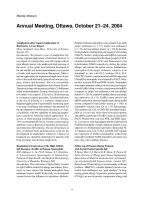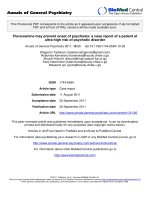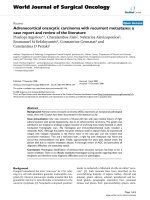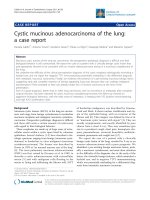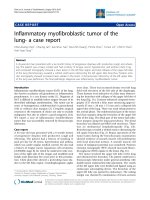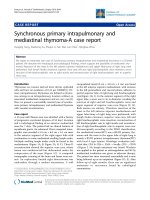Báo cáo y học: "Metabolic myopathy presenting with polyarteritis nodosa: a case report" doc
Bạn đang xem bản rút gọn của tài liệu. Xem và tải ngay bản đầy đủ của tài liệu tại đây (271.92 KB, 3 trang )
CAS E RE P O R T Open Access
Metabolic myopathy presenting with polyarteritis
nodosa: a case report
Sahana Vishwanath, Mishal Abdullah, Amro Elbalkhi and Julian L Ambrus Jr
*
Abstract
Introduction: To the best of our knowledge, we describe for the first time a patient in whom an unusual
metabolic myopathy was identified after failure to respond to curative therapy for a systemic vasculitis, polyarteritis
nodosa. We hope this report will heighten awareness of common metabolic myopathies that may present later in
life. It also speculates on the potential relationship between metabolic myopathy and systemic vasculitis.
Case presentation: A 78-year-old African-American woman with a two-year history of progressive fatigue and
exercise intolerance presented to our facility with new skin lesions and profound muscle weakness. Skin and
muscle biopsies demonstrated a medium-sized artery vasculitis consistent with polyarteritis nodosa. Biochemical
studies of the muscl e revealed diminished cytochrome C oxidase activity (0.78 μmol/minute/g tissue; normal range
1.03 to 3.83 μmol/minute/g tissue), elevated acid maltase activity (23.39 μmol/minute/g tissue; normal range 1.74
to 9.98 μmol/minute/g tissue) and elevated neutral maltase activity (35.89 μmol/minute/g tissue; normal range 4.35
to 16.03 μmol/minute/g tissue). Treatment for polyarteritis nodosa with prednisone and cyclophosphamide resulted
in minimal symptomatic improvement. Additional management with a diet low in complex carbohydrates and
ubiquinone, creatine, carnitine, folic acid, a-lipoic acid and ribose resulted in dramatic clinical improvement.
Conclusions: Our patient’s initial symptoms of fatigue, exercise intolerance and progressive weakness were likely
related to her compl ex metabolic myopathy involving both the mitochondrial respiratory chain and glycogen
storage pathways. Management of our patient required treatment of both the polyarteritis nodosa as well as
metabolic myopathy. Metabolic myopathies are common and should be considered in any patient with exercise
intolerance. Metabolic myopathies may complicate the management of various disease states.
Introduction
Metabolic myopathies are co mmon disorders that are
however rarely recognized in adults. They include var-
ious mitochondrial myopathies, glycogen storage dis-
eases and disorders of purine metabolism [1,2].
Common presentations in adults may include merely
exercise intolerance and muscle weakness with or with-
out pain [3]. Patients with metabolic myopathies clear
infections slowly and therefore may be more susceptible
to complications of chronic infections.
Polyarteritis nodosa (PAN) is a systemic vasculitis
involving medium-sized muscular arteries that has been
associated with various chronic infections including
hepatitis B, hepatitis C and parvovirus [4,5]. To the best
of our knowledge no previous case reports or studies
have examined an association between a metabolic myo-
pathy and polyarteritis nodosa.
Case presentation
A 78-year-old African American woman presente d to
our facility with a two-year history of progressiv ely wor-
sening fatigue and exercise intolerance. She lived alone
and had been independent in her activities of daily living
except for two occasions, six months and three months
prior to her admission to Buffalo General Hospital, NY,
USA, when she was admitted to the hospital for viral
syndromes with associated muscle weakness that
resolved in five to seven days. She was discharged with a
diagnosis of viral syndrome and dehydration. In the
three months prior to her admission to Buffalo General
Hos pital, she had note d progressively worsening muscle
weakness and pain, increasing to the point that she was
confined to a wheelchair. She had signif icant abdominal
* Correspondence:
Department of Medicine, SUNY at Buffalo School of Medicine, 100 High
Street, Buffalo, NY 14203, USA
Vishwanath et al. Journal of Medical Case Reports 2011, 5:262
/>JOURNAL OF MEDICAL
CASE REPORTS
© 2011 Vishwanath et al; licensee BioMe d Central Ltd. This is an Open Acc ess article distributed under the terms of the Creative
Commons Attribution License ( which permits unrestricted use, distribution, and
reproduction in any medium, provided the original work is properly cited.
pain and intermittent diarrhea. Her medical history was
also notable for hypothyroidism, for which she had been
treated with levothyroxine replacement for 35 years, and
hypertension. Her medications at the time of admission
were levothyroxine 125 μg daily, atenolol 50 mg daily,
aspirin 81 mg daily, calc ium 500 mg daily, omeprazole 20
mg daily and a multivitamin. Her physical examination
on admission was notable only for diminished muscle
strength in the proximal m uscles of the lower compared
to the upper extremities. There was no known family his-
tory of muscle problems. Notable laboratory study results
included: white blood cell count (WBC) = 31.6 × 10
9
cells/L, hemoglobin (HGB) = 7.7 g/dL, platelets = 464 ×
10
9
cell s/L, aspartate aminotransferase (AST) = 201 U/L,
alanine aminotransferase (ALT) = 206 U/L, lactate dehy-
drogenase (LDH) = 273 U/L, creatine kinase (CPK) = 14
U/L, erythrocyte sedimentation rate (ESR) >150 mm/
hour, C-reactive protein (CRP) = 182 mg/L, ferritin =
10,411 ng/mL, Urinalysis including microscopy was nor-
mal, thyroid stimu lating hormone (TSH) = 4.27 ulU/mL,
free thyroxine (T4) = 1.19 ng/dL, positive for cytoplasmic
ant i-neutrophil cytoplasmic antigen (C-ANCA) (>1:512),
negative for perinuclear ANCA (p-ANCA), a negative
hepatitis profile, positive for parvovirus IgG (3.9 index;
normal: <0.9) and negative for IgM. A computerized
tomography (CT) scan of the abdomen showed thicken-
ing of the colon consistent with ischemia and muscle
biopsy showed vasculitis involving muscular arteries and
arterioles consistent with polyarteritis nodosa. Treatment
was initiated with prednisone 60 mg daily and cyclopho-
sphamide 150 mg daily. After two weeks of therapy,
minimal clinical improvement was noted, although her
inflammatory parameters had decreased (WBC = 3.8 ×
10
9
cells/L, HGB = 10.3 g/dL, platelets = 262 × 10
9
cells/
L, ESR = 50 mm/hour, CRP = 22 mg/L, AST = 47 U/L,
Alt = 23 U/L, and ferritin = 2567 ng/mL). Biochemical
studies became available that demonstrated a defe ct in
the mitochondrial respiratory chain with a low cyto-
chromecoxidaselevelof0.78μmol/minute/g tissue
(normal range: 1.03 to 3.83 μmol/minute/g tissue), and
evidence of a lysosomal defect resulting in a secondary
glycogen storage disease with elevated acid maltase level
23.39 μmol/minute/g tissue (normal range: 1.74 to 9.98
μmol/minute/g tissue) and neutral maltase level 35.89
μmol/minute/g tissue (normal range: 4.35 to 16.03 μmol/
minute/g tissue). Our patient was treated with a diet free
of complex carbohydrates and a compound containing
ubiquinone, creatine, carnitine, folic acid, a-lipoic acid
and ribose, resulting in sl ow clinical improvement over
the next several months.
Discussion
We present the case of a patient with a complex meta-
bolic disorder involving defects in enzymes of the
mitochondrial respiratory chain a nd glycogen storage
pathways who developed a systemic vasculitis, resulting
in a need for acute medical attention. Treatment of the
vasculitis resulted in improvement in laboratory para-
meters but not in clinical symptoms. Symptomatic
improvement occurred with additional management of
the complex metabolic disease.
Several metabolic diseases are known to present in
adulthood and to be common in the gener al population.
Myoadenylate deaminase deficiency affects approxi-
mately 5% of the population, myophosphorylase defi-
ciency, a glycogen storage disease, affects 8% of the
population and various mitochondrial disorders exist in
between 1:1000 to 1:10,000 of the population, depending
upon various estimates [1,6-8]. Our patient had a mito-
chondrial respiratory chain defect along with an unusual
glycogen storage defect with high levels of lysosomal
acid and neutral maltase, likely resulting in reduced
cytosolic levels of these enzymes. It is possible that the
mitochondrial defect resulted from inadequately
replaced hypothyroidism, but there is no data to support
this hypothesis and our patient’sthyroidstudieswere
normal at the time of admission [9]. The manifestations
of these metabolic diseases in an adult are often merely
exercise intolerance and fatigue, which were getting
worse in our patient over a period of two years [1]. At
the same time, patients with metabolic diseases often
have difficulty clearing infections, and our patient had
two admissions for worsening muscle symptoms because
of viral infections even before the onset of her vasculitis
[10]. Interestingly, our patient did have positive IgG ser-
ology results for parvovirus, which has been associated
with polyarteritis nodosa [5,11]. I t is possible that diffi-
culty with clearing parvovirus led to immune complex
formation and secondary vasculitis, although there was
no evidence of ongoing parvovirus infection at her time
of admission to Buffalo General Hospital.
The manifestations of polyarteritis nodosa in our
patient were muscle pain and weakness, abdominal pain
and elevated inflammatory markers including ESR, CRP,
ferritin and platelets. She had a positiv e C-ANCA result
that is most commonly associated with Wegener granu-
lomatosis but can certainly be seen in polyarteritis
nodosa as well [12]. Our patient had a clinical picture
and muscle biopsy supporting a diagnosis of polyarteritis
nodosa but not Wegener granulomatosis. Interestingly,
treatment for polyarteritis nodosa, high-dose steroids
and cyclophosphamide, resulted in improvement in
inflammatory parameters with resolution of ab dominal
symptoms, but not muscle weakness. Improvement in
muscle weakness occurred over a period of months with
management of the metabolic disease.
The management of mitochondrial dysfunction is cur-
rently under investigation, but several approaches have
Vishwanath et al. Journal of Medical Case Reports 2011, 5:262
/>Page 2 of 3
been shown to be fruitful. Supplementing with ubiqui-
none (CoQ10), which transports electrons between com-
plex I and complex III of the mitochondrial respiratory
chain, has been shown to improve mitochondrial func-
tion in several studies [13]. Creatine is utilized to gener-
ate additional ATP through the creatine phosphate
shuttle [14]. Carnitine is added to en hance transport of
fatty acids into the mitochondria. Folic acid is a cofactor
for several mitochondrial enzymes. a-Lipoic acid is a
strong antioxi dant [15]. In the management of glycogen
storage diseases, complex car bohydrates are avoided and
simple sugars, such as ribose, are utilized to provide a
moreavailableenergysource[3,16].Thisstrategy
resulted in significant symptomatic improvement in our
patient.
It has recently been noted that patients who have
inflammatory muscle diseases that do not respond to
immunosuppressive therapies as expected often have
underlying metabolic muscle diseases. This is the first
documented case of a vasculitis with incomplete clinical
response to immunosuppressive therapy in which the
management of a complex metabolic disorder was
necessary for symptomatic relief [17,18]. This case
should alert physicians to include various common adult
onset metabolic disorders in the investigation of symp-
tom complexes including fatigue and various muscle
problems.
Conclusions
To the best of our knowledge, this report describes for
the first time a patient in which symptomatic improve-
ment of a systemic vasculitis required the simultaneous
management of a metabolic myopathy. Since metabolic
myopathies are common, they should always be consid-
ered when inflammatory diseases are not responding to
standard therapies as expected.
Consent
Written informed consent was obtained from the patient
for publication of this case report and any accompany-
ing images. A copy of the writ ten consent is available
for review by the Editor-in-Chief of this journal.
Authors’ contributions
All authors participated in the care of our patient and the writing of this
manuscript. All authors read and approved the final manuscript.
Competing interests
The authors declare that they have no competing interests.
Received: 7 January 2011 Accepted: 30 June 2011
Published: 30 June 2011
References
1. Berardo A, DiMauro S, Hirano M: A diagnostic algorithm for metabolic
myopathies. Curr Neurol Neurosci Rep 2010, 10:118-126.
2. Di Donato S: Multisystem manifestations of mitochondrial disorders. J
Neurol 2009, 256:693-710.
3. Burra ML, Roos JC, Ostor AJK: Metabolic myopathies: a guide and update
for clinicians. Curr Opin Rheumatol 2008, 20:639-647.
4. Cohen P, Guillevin L: Vasculitis associated with viral infections. Presse
Medicale 2004, 33:1371-1384.
5. Pagnoux C, Cohen P, Guillevin L: Vasculitides secondary to infections. Clin
Exp Rheumatol 2006, 24:S71-S81.
6. Angelini C, Semplicini C: Metabolic myopathies: the challenge of new
treatments. Curr Opin Pharmacol 2010, 10:338-345.
7. Teijeira S, Millan BS, Fernandez JM, Rivas E, Vieitez I, Miranda S, Gonzalez F,
Navarro C: Myoadenylate deaminase deficiency: clinico-pathological and
molecular study of a series of 27 Spanish cases. Clin Neuropathol 2009,
28:136-142.
8. Wallace DC: Mitochondrial DNA mutations in disease and aging. Environ
Mol Mutagen 2010, 51:440-450.
9. Harper ME, Seifert EL: Thyroid hormone effects on mitochondrial
energetics. Thyroid 2008, 18:145-156.
10. Arnoult D, Carneiro L, Tattoli I, Girardin SE: The role of mitochondria in
cellular defense against microbial infection. Semin Immunol 2009,
21:223-232.
11. Magro CM, Crowson AN, Dawood M, Nuovo GJ: Parvoviral infection of
endothelial cells and its possible role in vasculitis and autoimmune
diseases. J Rheumatol 2002, 29:1227-1235.
12. Ito Y, Nishi A, Sakaguchi M, Suzuki Y, Kaneko K, Yasuoka C, Tomita S, Kato H:
Anti-neutrophil cytoplasmic antibody for proteinase 3 in a child with
polyarteritis nodosa. Acta Paediatr Jpn 1995, 37:116-119.
13. Haas RH: The evidence basis for coenzyme Q therapy in oxidative
phosphorylation disease. Mitochondrion 2007, 7(Suppl):S136-145.
14. Adhihetty PJ, Beal MF: Creatine and its potential therapeutic value for
targeting cellular energy impairment in neurodegenerative diseases.
Neuromol Med 2007, 10:275-290.
15. Tarnopolsky MA: The mitochondrial cocktail: rationale for combined
nutraceutical therapy in mitochondrial cytopathies.
Adv Drug Deliv Rev
2008, 60:1561-1567.
16. Quinlivan RM, Beynon RJ: Pharmacological and nutritional treatment trials
in McArdle disease. Acta Myol 2007, 26:58-60.
17. Temiz P, Weihl CC, Pestronk A: Inflammatory myopathies with
mitochondrial pathology and protein aggregates. J Neurol Sci 2009,
278:25-29.
18. Varadhachary AS, Weihl CC, Pestronk A: Mitochondrial pathology in
immune and inflammatory myopathies. Curr Opin Rheumatol 2010,
22:651-657.
doi:10.1186/1752-1947-5-262
Cite this article as: Vishwanath et al.: Metabolic myopathy presenting
with polyarteritis nodosa: a case report. Journal of Medical Case Reports
2011 5:262.
Submit your next manuscript to BioMed Central
and take full advantage of:
• Convenient online submission
• Thorough peer review
• No space constraints or color figure charges
• Immediate publication on acceptance
• Inclusion in PubMed, CAS, Scopus and Google Scholar
• Research which is freely available for redistribution
Submit your manuscript at
www.biomedcentral.com/submit
Vishwanath et al. Journal of Medical Case Reports 2011, 5:262
/>Page 3 of 3
